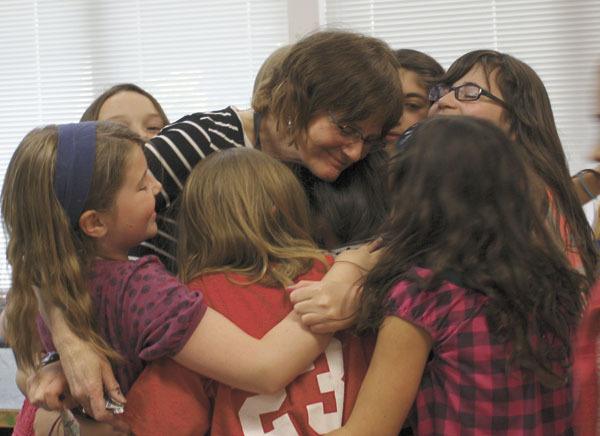As Carolyn Buehl began to pack up her classroom at Chautauqua Elementary School last week, organizing art supplies and wrapping delicate monkey masks to send home with students, she pulled out an old photo album. Inside the album was photo after photo of colorful student art, many of it held by grinning young artists.
“Some of the kids in there just graduated from VHS,” Buehl said with a smile.
Several of the projects in the photos — animals, insects and planets — complemented what the students were learning in their classrooms at the time, while others mimicked artists the kids studied in Buehl’s class, such as Georgia O’Keefe or Andy Warhol. And for some projects, Buehl, a spunky and energetic older woman, simply played music and asked children to draw what the sounds made them think of.
“If you have an artistic vision, she lets you pursue it instead of telling you what to do,” said Cyrus Sweet, a fifth-grader. “I think that’s why kids behave better in her class.”
This year Chautauqua said goodbye to Buehl, who, after more than 20 years teaching art at the school district, has become known as a beloved mentor, a creative teacher and a talented artist in her own right. A group hug that energetic fifth-graders gave Buehl last week on one of the last school days epitomizes how class after class of elementary school students have grown to adore her.
“She has a very fanciful, energetic and yet disciplined approach of bringing artistic expression into kids’ lives,” said Pam McMahn, who heads the Vashon Artists in the Schools Program and whose own children had Buehl as a teacher. “She’s not afraid to experiment with nontraditional ways of opening kids’ eyes to the beauty of visual art.”
Gail Labinski, who used to teach art at Chautauqua as well and is now a reading specialist, says she’s seen countless children come alive in Buehl’s classroom. Buehl creates an environment where students can be creative within certain parameters, Labinski said, and where they learn that there are no mistakes in art.
“Add a whacky nature and a great storyteller, and she’s an experience,” Labinski said. “And it’s one you can’t replicate.”
Patricia Toovey, an artist who has volunteered in Buehl’s classroom as part of the Vashon Artists in the Schools program, agreed. Recalling the time Buehl created the frame of a nearly life-size orca and let children decorate the outside, Toovey said Buehl has a way of “making the bones and hanging the creative expression on that.”
“I’ve seen kids that are not maybe prosperous in other aspects of their schooling that thrive in that environment,” Toovey said.
Struggling in school is a story that’s all too familiar to Buehl. She herself is dyslexic.
Unlike her own students, Buehl grew up in a time when not much was known about dyslexia, and children who suffered from it didn’t get the help they needed in school.
“I had teachers tell me I was so stupid I would never succeed at anything,” Buehl recalled. “They had me standing in corners and all kinds of stuff.”
But art class was where Buehl thrived, and to this day she credits an art teacher she had in fifth and sixth grade with turning her life around.
“(She) kept me alive. … She provided a venue for me to show my abilities, and I never had that before,” Buehl said. “Art is such a good tool for self-esteem.”
Eventually Buehl graduated high school with a C average and went on to earn a bachelor’s degree in art education as well as a master’s degree in drawing.
In the late 1980s, as an artist who taught summer camps for Vashon Allied Arts, Buehl approached the superintendent of the Vashon Island School District, which at the time did not have a dedicated elementary art teacher.
“All my life I had been one of the those kids on the margin, and art spoke to me. I said, ‘I want to know who is speaking for those children.’ I said, ‘Hire me, and I’ll push a cart.’”
Buehl did push a cart at first, and eventually got her own classroom. Early on in her career she helped spearhead the Vashon Artists in the Schools program, and she has continued to take art classes in her spare time.
“I always say you can’t feed others unless you’re feeding yourself,” she said.
Over the years, Buehl said, she has seen herself in children who struggle in other subjects but thrive with a paintbrush in their hands.
“I make sure I check on them, and I make sure sometimes that they know my story, because it’s huge for them,” she said.
Retirement is bittersweet for Buehl. She’ll miss teaching dearly, she said, but is looking forward to spending time with her husband and focusing on her own art, which has ranged from drawings of anthropomorphic animals to more expressionistic paintings and prints.
While colleagues, parents and students all laud the retiring teacher, she is quick to ward off their praises, saying instead she’s been blessed to be able to teach. Last week at a retirement party, teachers presented Buehl with a Native American blanket and thanked her for what she’s done at Chautauqua, and Buehl, tearful at times, simply returned their remarks.
“I have so much respect for all of you and the work you do with children,” she said.
Even in the classroom, Buehl says it’s her students who have inspired her.
Last year she decided to make felt hats with the children, a huge undertaking. When the the project was finally complete, Beuhl said each hat looked just like the student who made it.
“Each child has so much creativity. What is important is you just have to fan their flame,” Buehl said. “What am I going to do now? I’m going to fan my own flame.”



